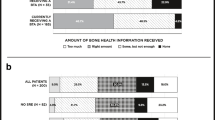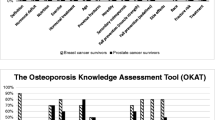Abstract
Summary
This study investigates, in women diagnosed with breast cancer, the feasibility of evaluating the effects of educational material and its delivery method, on bone health management. The study results suggest educational material may improve rates of bone mineral density testing.
Introduction
Educational materials improve bone mineral density (BMD) testing rates in high-risk patients, but the effect is unknown in women diagnosed with breast cancer. Methods of delivering educational materials may also affect testing rates. The purposes of this study were to determine the feasibility of the protocol and to pilot-test the effects of educational material and its delivery methods on BMD testing rates.
Method
Pilot randomized controlled trial with block randomization. Fifty-four women (aged 65–75 and diagnosed with breast cancer ≥ 3 years ago (2010–2012) and not taking osteoporosis medication) were recruited from February to May 2016 and randomized to three groups: control without educational material, educational material delivered by postal mail, and educational material delivered by patient choice of postal mail, email, or text messaging. Outcome measures were primarily evaluated using self-report questionnaires.
Results
The participation rate, defined as the proportion of eligible participants who consented to participate, was 39.1%. Primary outcome measure was obtained for 98% of the recruited women. During the 6-month follow-up period, BMD testing rates were significantly higher in the groups receiving educational materials by mail (26%, 95%CI = 10 to 49) and by patient choice (18%, 95%CI = 5 to 41), when compared with the control group (6%, 95%CI = 0.3 to 25). Educational material was associated with a 17% higher BMD testing rate.
Conclusions
The study protocol is feasible for a large-scale study. The educational material intervention is broadly accepted by the study participants with a promising positive effect on BMD testing rates.

Similar content being viewed by others
Abbreviations
- BC :
-
British Columbia
- BMD :
-
Bone Mineral Density
- CAT :
-
Calcium Assessment Tool
- CI :
-
Confidence Interval
- DXA :
-
Dual energy X-ray absorptiometry
- FRAX :
-
Fracture risk assessment tool
- GLTEQ :
-
Godin Leisure-Time Exercise Questionnaire
- RCT :
-
Randomized Controlled Trial
- SD :
-
Standard deviation
- VIDSUN :
-
Vitamin D & Sun
References
Kanis JA on behave of the World Health Organizaiton Scientific Group (2007) Assessment of osteoporosis at the primary health care level. Technical Report. University of Sheffield, UK
Melton LJ, Chrischilles EA, Cooper C, Lane AW, Riggs BL (2005) How many women have osteoporosis? (Reprinted from Journal Bone & Mineral Research, vol 7, pg 1005, 1992). J Bone Miner Res 20:886–892
Kanis JA, Johnell O, Oden A, Sembo I, Redlund-Johnell I, Dawson A, De Laet C, Jonsson B (2000) Long-term risk of osteoporotic fracture in Malmo. Osteoporos Int 11:669–674
Bonar SK, Tinetti ME, Speechley M, Cooney LM (1990) Factors associated with short- versus long-term skilled nursing facility placement among community-living hip fracture patients. J Am Geriatr Soc 38:1139–1144
Cummings SR, Melton LJ (2002) Epidemiology and outcomes of osteoporotic fractures. Lancet 359:1761–1767
Chrischilles EA, Butler CD, Davis CS, Wallace RB (1991) A model of lifetime osteoporosis impact. Arch Intern Med 151:2026–2032
Burge R, Dawson-Hughes B, Solomon DH, Wong JB, King A, Tosteson A (2007) Incidence and economic burden of osteoporosis-related fractures in the United States, 2005-2025. J Bone Miner Res 22:465–475
Chen Z, Maricic M, Bassford TL, Pettinger M, Ritenbaugh C, Lopez AM, Barad DH, Gass M, LeBoff MS (2005) Fracture risk among breast cancer survivors—results from the Women's Health Initiative observational study. Arch Intern Med 165:552–558
Bell R, Lewis J (2007) Assessing the risk of bone fracture among postmenopausal women who are receiving adjuvant hormonal therapy for breast cancer. Curr Med Res Opin 23:1045–1051
Lustberg MB, Reinbolt RE, Shapiro CL (2012) Bone health in adult cancer survivorship. J Clin Oncol 30:3665–3674
Abdel-Razeq H, Awidi A (2011) Bone health in breast cancer survivors. J Cancer Res Ther 7:256–263
Papaioannou A, Morin S, Cheung AM, Atkinson S, Brown JP, Feldman S, Hanley DA, Hodsman A, Jamal SA, Kaiser SM, Kvern B, Siminoski K, Leslie WD, for the Scientific Advisory Council of Osteoporosis Canada (2010) 2010 clinical practice guidelines for the diagnosis and management of osteoporosis in Canada: summary. CMAJ 182:1864–1873
Laliberté MC, Perreault S, Jouini G, Shea BJ, Lalonde L (2011) Effectiveness of interventions to improve the detection and treatment of osteoporosis in primary care settings: a systematic review and meta-analysis. Osteoporosis Int 22:2743–2768
Little EA, Eccles MP (2010) A systematic review of the effectiveness of interventions to improve post-fracture investigation and management of patients at risk of osteoporosis. Implement Sci 5
Clark SJ, Butchart A, Kennedy A, Dombkowski KJ (2011) Parents' experiences with and preferences for immunization reminder/recall technologies. Pediatrics 128:e1100–e1105
Baptist AP, Thompson M, Grossman KS, Mohammed L, Sy A, Sanders GM (2011) Social media, text messaging, and email—preferences of asthma patients between 12 and 40 years old. J Asthma 48:824–830
(2015) BC Cancer Agency Registry Data and Breast Cancer Outcomes Unit Data. In Agency BC (ed). British Columbia Cancer Agency [Publisher], Vancouver, BC
Kanis JA, McCloskey EV, Johansson H, Oden A, Strom O, Borgstrom F (2010) Development and use of FRAX in osteoporosis. Osteoporos Int 21(Suppl 2):S407–S413
Godin G, Shephard R (1997) Godin leisure-time exercise questionnaire. Med Sci Sports Exerc 29:36–38
Nabak AC, Johnson RE, Keuler NS, Hansen KE (2014) Can a questionnaire predict vitamin D status in postmenopausal women? Public Health Nutr 17:739–746
Hung A, Hamidi M, Riazantseva E, Thompson L, Tile L, Tomlinson G, Stewart B, Cheung AM (2011) Validation of a calcium assessment tool in postmenopausal Canadian women. Maturitas 69:168–172
Leslie WD, Lix LM, Langsetmo L, Berger C, Goltzman D, Hanley DA, Adachi JD, Johansson H, Oden A, McCloskey E, Kanis JA (2011) Construction of a FRAX® model for the assessment of fracture probability in Canada and implications for treatment. Osteoporosis Int 22:817–827
Levy Milne R, Forster-Coull L, Barr SI, British Columbia, Ministry of Health Services, Canada Health Canada, University of British Columbia, British Columbia Government EBook Collection (2004) British Columbia nutrition survey report on seniors' nutritional health. Ministry of Health services,, Victoria, B.C., pp 1 online resource (viii, 51 p)
Basen-Engquist K, Chang M (2011) Obesity and Cancer risk: recent review and evidence. Curr Oncol Rep 13:71–76
Demark-Wahnefried W, Campbell K, Hayes SC (2012) Weight management and its role in breast Cancer rehabilitation. Cancer 118:2277–2287. https://doi.org/10.1002/cncr.27466
Blaney J, Lowe-Strong A, Rankin J, Campbell A, Allen J, Gracey J (2010) The Cancer rehabilitation journey: barriers to and facilitators of exercise among patients with Cancer-related fatigue. Phys Ther 90:1135–1147
Rogers LQ, Courneya KS, Shah P, Dunnington G, Hopkins-Price P (2007) Exercise stage of change, barriers, expectations, values and preferences among breast cancer patients during treatment: a pilot study. Eur J Cancer Care 16:55–66
Hsieh C, Novielli KD, Diamond JJ, Cheruva D (2001) Health beliefs and attitudes toward the prevention of osteoporosis in older women. Menopause 8:372–376
Grover ML, Edwards FD, Chang YH, Cook CB, Behrens MC, Dueck AC (2014) Fracture risk perception study: patient self-perceptions of bone health often disagree with calculated fracture risk. Women's Health Issues 24:e69–e75
Olivia LT, John JS, Carolyn CG, Wan YH, Mary LM, Martin GD (2018) Aromatase inhibitors are associated with a higher fracture risk than tamoxifen: a systematic review and meta-analysis. Ther Adv Musculoskelet Dis 10:71–90
Wan D, Villa D, Woods R, Yerushalmi R (2016) Gelmon K breast Cancer subtype variation by race and ethnicity in a diverse population in British Columbia. Clinical Breast Cancer 16:e49–e55
Quay TA, Frimer L, Janssen PA, Lamers Y (2017) Barriers and facilitators to recruitment of south Asians to health research: a scoping review. BMJ Open 7:e014889
Acknowledgments
The authors thank pharmacist Jin Qing Pan for reviewing medication dispensing records and the Centre of Excellence in Cancer Prevention, a partnership between the Canadian Cancer Society and the University of British Columbia’s School of Population and Public Health, for facilitating development of the educational material. The first author, Dr. Olivia L. Tseng, was financially supported by a Clinician Scholarship through the Department of Family Practice of University of British Columbia and a Roman M. Babicki Fellowship in Medical Research through the University of British Columbia.
Funding
This study was supported by Janus research Award from the College of Family Physicians Canada.
Author information
Authors and Affiliations
Corresponding author
Ethics declarations
Ethical approval
This study has been approved by the University of British Columbia/BC Cancer Agency Ethics Board (H15-00849).
Conflicts of interest
None.
Additional information
Originality of Work and Previous Presentation of Manuscript
This work is completely original.
Rights and permissions
About this article
Cite this article
Tseng, O.L., Spinelli, J.J., Gotay, C.C. et al. Promoting bone health management in women diagnosed with breast cancer: a pilot randomized controlled trial. Arch Osteoporos 13, 52 (2018). https://doi.org/10.1007/s11657-018-0469-x
Received:
Accepted:
Published:
DOI: https://doi.org/10.1007/s11657-018-0469-x




